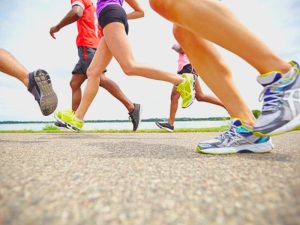The legs of a dedicated biker or a top marathon runner are often used to identify them. Cyclist legs vs Runner’s legs often have different appearances due to the type of workouts they complete and the natural body types of each discipline.
Riders are recognized for their highly ripped and vascular legs, but muscular development in cyclists isn’t always as balanced. Runners’ legs appear slimmer, but their leg work is frequently better balanced across all muscles. Let’s look at why bikers and runners have the legs they do and why there is such a disparity between the two groups.
Table of Contents
ToggleCycling or Running: Which Muscle Groups Are Used?
To understand how the legs of a long-distance runner differ from those of a long-distance cyclist, it is necessary first to understand how the two activities differ.

First, both require hard training, but the natural challenges of cycling, such as climbing hills, stops and starts, and sprints, make it an even more severe physical workout. Running is frequently done at a tempo, but sprinters’ routines are notable exceptions.
Second, the heart and lung effects – VO2 max – on runners are frequently more demanding than on cyclists, limiting how long they can go all-out.
Third, because running uses more leg muscle groups than cycling, it provides a better-balanced workout with no one muscle group overdeveloping. We’ll go through that in greater detail later.
To learn more about the muscles trained during cycling, click Here (What muscles does cycling work).
Leg Differences Between Cyclists and Runners
Sprinters’ legs compared to cyclists’ legs:

Most of this page is aimed at endurance athletes, such as long-distance runners and cyclists. It should be noted that endurance runners and sprinters develop their legs quite differently.
Most sprinters develop legs that resemble those of a professional cyclist over time. There’s a lot of emphasis on glute and quad development. Do you want to know either Cycling makes your legs bigger?
Cycling promotes quad development more than jogging.
The quadriceps are the largest muscles in the body, accounting for a considerable portion of a cyclist’s leg muscle. If you aim to be a good cyclist, your quad strength must be exceptional, especially on uphill rides. This results in a “teardrop” shaped quad muscle just above the knee for riders. This form is well-known among cyclists, and many consider it to be both aesthetically beautiful and desirable. This quad development is most visible in persons who engage in spin and HIIT-heavy cycling regimens, such as those who frequently attend spin classes or ride on an indoor bike trainer.
On the other hand, runners still use their quads, albeit to a lesser extent. They don’t require nearly as much quad strength as the Cyclists need. Running requires the use of the hamstrings, glutes, hip flexors, calves, and core muscles simultaneously. All of these muscles must be trained and developed for overall performance, which means the quads do not need to be as strong because they do not do the majority of the work.
Endurance runners employ more muscle units in their legs than endurance cyclists:
Running engages numerous leg muscle groups. A runner with good form will employ the quads, hamstrings, glutes, groin, and the front and rear of the calves. Everything is on the table. However, no single muscle group will dominate the entire process unless you are a speedster. Running races are won with a balanced, almost boring leg.
Cycling primarily engages two muscular groups: the hamstrings and the glutes. While it is not as balanced, it will strengthen the quads and glutes to a more refined and ripped appearance. If you are a Cyclist and want to calculate your functional threshold power then simply use our FTP Calculator.
Cycling requires shorter, more muscular legs than jogging.
When running, speed equals stride length multiplied by stride frequency. A runner with lengthy legs and rapid twitch muscle fibers is gifted and capable of training their way to the top of the endurance sport.

Someone with shorter, meatier legs may struggle to keep up in a 5K, but they may excel on the bike. Cyclists must pedal in short circles fast and forcefully, which needs a lot of leg strength. This is especially true for professional cyclists who are continually training and competing at a high level and ride uphill.
Cyclist legs vs runner’s legs do not require as much quad strength because they do not perform the same type of brief bursts of movement. They must be able to go large distances yet not generate the same level of power. As a result, running is more suited to endurance exercise, whereas cycling is more suited to power.
Runners’ legs are typically less vascular.

This is one of the most obvious distinctions between cyclists’ legs and runners’ legs. Cyclists typically have vascular legs, which is a result of all the blood that is pumped to the muscles when they are pushing hard to pedal swiftly. Cycling enthusiasts refer to their legs as having “spider veins,” blood vessels that are so near the skin’s surface that they resemble spider webs. It’s a lot like lifting weights in the gym.
Runners will have less blood flow to their legs because they are not performing the same type of intensive workout. This lack of blood flow is why runners have lower vascular legs than bikers. However, depending on their genetics and how much they exercise, some runners may be more vascular than others.
The obvious exception is sprinters’ legs, which can be exceptionally vascular and muscular. However, endurance runners typically have significantly thinner legs as compared to cyclists’ legs.
The legs of advanced Cyclists may resemble those of bodybuilders:
If you’ve ever seen a professional or even an amateur cyclist in person or on video, you’ll notice that their legs can resemble those of bodybuilders. It is because muscle fibers are classified into two types: slow-twitch and fast-twitch. Cyclists engage more fast-twitch muscle fibers to generate more power at higher cadences. Bodybuilders also use more fast-twitch muscle fibers during weightlifting to grow bigger muscles. This is why the two groups have many characteristics, such as ripped and defined legs.
Runners employ more slow-twitch muscle fibers for endurance exercise, which is great for long-distance training. As a result, runners’ legs are smaller than those of cyclists and bodybuilders. However, in terms of performance, having a strong definition isn’t always necessary. Therefore, having smaller or less developed leg muscles may be irrelevant. Cyclists and runners both train their muscles to do well in their respective sports, and both have incredible physiques. When comparing the two, it all comes down to what you’re looking for.
Training can help runners build better-contoured legs:
Although if we compare Cyclist Legs vs Runners Legs, it is obvious that cyclists have larger legs than runners, it is crucial to remember that runners can grow the same sort of legs if they train particularly for it. Most people in the fitness sector are already familiar with this form of training. To gain bigger legs, runners must add strength-training workouts that focus on muscle mass building, particularly in the quads, calves, and hamstrings. Squats, deadlifts, and leg presses are examples of these exercises.
Aside from weightlifting, runners can benefit from sprints and other types of high-intensity interval training (HIIT) to increase muscle growth and definition. Running uphill is an excellent technique to build bigger legs because each step requires you to generate more power. Because strength training and long-distance running are two very distinct types of exercise, it may be challenging for runners to combine the two.

